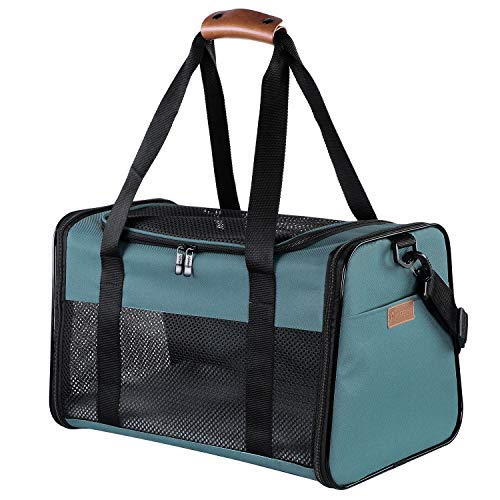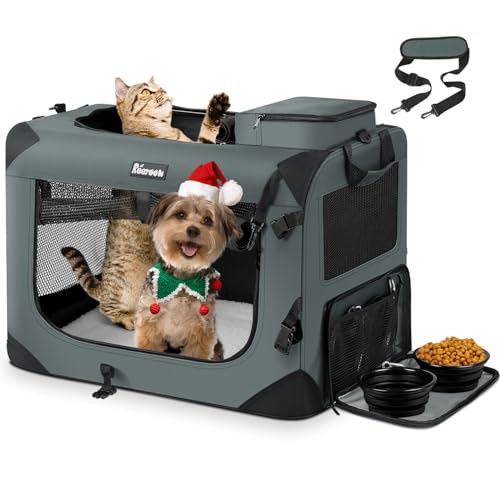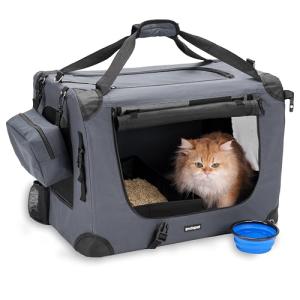The thought of traveling with a cat can conjure up a range of images for pet owners, and rarely are they serene. More often, visions of frantic meowing, visible stress, and a general state of feline chaos fill the mind. Whether it’s a necessary move across the country, a long-awaited vacation where you refuse to leave your furry family member behind, or even just a routine trip to the vet that’s a bit further afield than usual, travel with cats can be inherently challenging. However, the key to transforming a potentially stressful ordeal into a manageable, and even dare we say, enjoyable journey, lies in meticulous preparation and ensuring you have the right supplies at hand. Careful planning and a well-stocked travel kit aren't just about convenience; they are absolutely fundamental for guaranteeing the safety and comfort of your cat throughout the trip. Being adequately prepared is paramount to prevent escapes, mitigate accidents, and address any health concerns that might arise while away from home. It’s also crucial for minimizing stress for your feline companion, making the journey as tolerable as possible, and ultimately providing you, the devoted owner, with invaluable peace of mind, knowing you’re equipped to handle almost anything the road might throw your way. This article will serve as your definitive guide to assembling the ultimate travel kit for your cat. We will delve into a detailed checklist of essential supplies, covering everything you need for safe, comfortable, and stress-minimized travel, regardless of your mode of transport or destination. From safety essentials and comfort must-haves to crucial health and emergency preparedness items, we will leave no stone unturned, ensuring you are fully equipped to embark on your journey with confidence and your cat by your side, purring, or at least tolerating, the adventure.
At the very foundation of safe cat travel lies a set of essential safety supplies, without which, embarking on any journey would be imprudent. The cornerstone of cat travel safety is undoubtedly a secure cat carrier. The debate between hard-sided and soft-sided carriers often surfaces, and for travel safety, both have their merits. Hard-sided carriers generally offer superior protection, particularly for air travel where carriers might endure rough handling. Their rigid structure provides better impact resistance and a more secure, enclosed environment. Soft-sided carriers, on the other hand, can be lighter and more adaptable, often fitting more easily under airplane seats for in-cabin travel, and they can be less bulky for car journeys. However, regardless of your preference, the critical factor for travel is security. Choose a carrier that is appropriately sized, allowing your cat to stand, turn around, and lie down comfortably, but not so large that they might get tossed around during transit. For air travel, airline compliance is paramount, and you must ensure your carrier meets the specific size and construction regulations of your chosen airline, especially if your cat is traveling in the cabin. Beyond size, focus on the carrier’s security features. Robust latches and zippers are non-negotiable. Opt for carriers with escape-proof designs, ensuring that determined paws and noses can’t easily open closures. For soft-sided carriers, look for reinforced frames and sturdy zippers with locking mechanisms if possible. For hard-sided carriers, confirm that the latches are strong and securely fasten the doors. Finally, and critically, always label the carrier clearly. Attach a durable identification tag to the carrier itself, displaying your name, phone number, and your final destination information. This is especially vital for air travel where carriers can be separated from owners during baggage handling, but it's also a good practice for car travel in case of emergencies.
Beyond the carrier itself, ensuring your cat’s proper identification is the next layer of crucial safety. Even in the most secure carrier, unforeseen circumstances can occur, and having multiple forms of identification dramatically increases the chances of your cat being safely returned to you if they were to become separated. A traditional collar with ID tags is a fundamental form of identification. Ensure your cat wears a durable, well-fitting collar – ideally a breakaway collar for safety in everyday life but a secure, non-breakaway collar might be considered for travel to prevent accidental loss. Attach clearly legible ID tags displaying your permanent contact information at home and, crucially, your temporary contact information for your travel destination, including a phone number where you can be reached while on your trip. Microchipping is an invaluable backup to physical ID tags. A microchip, permanently implanted under your cat’s skin, provides a virtually irremovable form of identification. Ensure your cat is microchipped, and absolutely verify that your registration information is up-to-date with your current contact details, including a phone number that will be active during your travel. Update this registration with your travel destination address if you are moving permanently. In addition to collar tags and microchips, consider temporary travel ID options for extra security, especially for longer journeys or travel to unfamiliar locations. Paper collar tags, easily written and attached to the collar, can display your temporary travel contact information prominently. Temporary pet tattoos, using pet-safe ink, can also be used to add temporary travel details directly onto your cat’s fur for added reassurance, although these are less common.
For specific controlled situations during travel, especially car journeys, a leash and harness can be a valuable safety tool, but their use must be approached with caution and common sense. A harness and leash can be incredibly helpful for preventing escapes during necessary stops on car trips, such as bathroom breaks or brief outdoor access at rest areas. However, this should only be considered for cats who are already leash-trained and comfortable wearing a harness. Choosing the right harness is critical. Opt for cat-specific harnesses, either H-style harnesses or vest-style harnesses, designed to be escape-proof and secure, yet comfortable for your cat to wear for short periods. Ensure the harness fits snugly but not too tightly, allowing for two fingers to slip comfortably underneath. Before your trip, if you intend to use a harness and leash during travel, it's crucial to engage in pre-trip leash training at home. Gradually acclimate your cat to wearing the harness indoors, and then progress to short, supervised leash walks in a safe, enclosed area. This training ensures that using a harness and leash during travel is less stressful and more controlled. However, it's equally important to understand when a leash and harness are not recommended. Avoid using a leash and harness in highly stressful or unpredictable environments like airports, busy train stations, or crowded rest stops. In such situations, the risk of escape or further stressing your cat outweighs the perceived benefits. The primary purpose of a leash and harness for travel is for controlled, very brief, and supervised outdoor access during car travel stops for bathroom breaks if your cat is already comfortable and trained. It's not intended for leisurely walks or extended outdoor exposure during travel.
Finally, when considering essential safety supplies, particularly for air travel or crossing borders, travel documents and paperwork become critical. For air travel, and often for crossing state or international borders, a health certificate from your veterinarian might be required. Research the specific regulations of your airline and your destination well in advance of your travel dates. Obtain a health certificate from your veterinarian within the timeframe stipulated by the airline or border control, typically within 10 days of travel. This certificate confirms that your cat is healthy enough to travel and is free from contagious diseases. Vaccination records are another essential piece of paperwork to keep readily accessible during travel. Carry copies of your cat's vaccination records, especially rabies vaccination, as these may be required for boarding facilities, veterinary visits during your trip, or when crossing borders. If you are flying with your cat, familiarize yourself with and pre-fill any airline pet travel forms required by your chosen airline. Having these documents prepared in advance streamlines the check-in process and minimizes stress at the airport. Keep all travel documents, health certificates, vaccination records, and airline forms organized and easily accessible throughout your journey. A dedicated travel folder or pouch for these important papers is highly recommended.
While safety is paramount, ensuring your cat’s comfort during travel is equally vital for a smoother and less stressful journey for both of you. Comfort supplies transform a carrier from a mere container into a more welcoming and den-like space, minimizing anxiety and making travel more tolerable for your feline companion. Comfortable bedding is the first step in creating a cozy travel haven. Bringing a familiar blanket or bed from home is invaluable. The familiar scent of home on the bedding provides reassurance and reduces anxiety in a new and potentially overwhelming environment. Line the carrier with absorbent pads, such as disposable pet accident pads or puppy pads. These are essential for managing any accidents or spills within the carrier, keeping your cat dry and comfortable throughout the journey. Depending on the climate and season of your travel, consider using cooling or warming pads to regulate the temperature inside the carrier. Cooling mats can help prevent overheating in warm weather, while warming pads provide extra warmth in cold climates.
Ensuring your cat has access to food and water during the journey, particularly for longer trips, is crucial for their well-being. Pack travel food bowls and water dishes specifically designed for pet travel. Spill-proof bowls and dishes are essential to minimize messes during transit. Collapsible bowls are lightweight and space-saving, ideal for travel kits. Familiar food is a must. Bring an adequate supply of your cat’s regular food from home. Abrupt dietary changes during travel can easily lead to digestive upset and further stress for your cat. For water, carry bottled water or ensure access to safe drinking water throughout your journey. Offer water to your cat regularly, especially during car travel stops and layovers. Treats are more than just rewards; they are valuable tools for positive reinforcement and distraction during travel. Pack your cat's favorite treats to reward calm behavior within the carrier, and to distract them during potentially stressful moments, such as during boarding or security checks.
For any journey beyond a short vet visit, providing a litter box and litter for on-the-go elimination is a necessity. Disposable litter box options are ideal for travel. Cardboard litter boxes, collapsible travel litter boxes, or commercially available disposable litter boxes are lightweight, space-saving, and easy to discard after use. Travel litter should also be lightweight and convenient. Pack small bags of your cat's regular litter to maintain familiarity, or opt for lightweight travel litter options. Don't forget a scoop and waste bags. These are essential for maintaining hygiene and responsibly disposing of waste during travel stops. Sealable waste bags help contain odors. Litter box wipes or sanitizer are helpful for quickly cleaning up any accidents around the travel litter box and maintaining hygiene.
Finally, consider climate control and weather protection when packing comfort supplies. A cooling vest or mat can be a lifesaver for travel in hot weather or during summer months. These help prevent overheating and keep your cat comfortable in warm environments. Conversely, a warming blanket or coat is essential for protecting your cat from chills in cold climates or during winter travel, particularly during air travel where temperatures in cargo holds can fluctuate. A carrier cover or shade provides versatile weather protection. It offers shade from direct sunlight, reduces heat buildup in warm weather, and provides a degree of rain protection if you need to briefly carry the carrier outdoors in wet conditions. Additionally, a carrier cover can create a darker, more enclosed space, which can be comforting for anxious cats who prefer reduced visual stimuli.
Health and emergency preparedness supplies are not just about anticipating worst-case scenarios; they are about responsible pet ownership and ensuring you can address any minor health issues or unexpected emergencies that might arise while traveling. A travel-sized first-aid kit specifically for cats is an essential inclusion in your travel supplies. Pack basic first-aid supplies, including antiseptic wipes for cleaning minor wounds, bandages and gauze for wound care, medical tape for securing bandages, cotton balls for applying antiseptics, tweezers for removing splinters or debris, and small scissors for trimming fur around wounds or cutting bandages. Include cat-specific first-aid items, such as a pet-safe antiseptic spray for treating minor cuts and abrasions, and styptic powder to stop bleeding from minor cuts or scratches, particularly to nails if accidentally trimmed too short. A blunt-tipped syringe is useful for administering oral medications or flushing wounds with water or saline solution. Critically, if your cat is on any regular medications, ensure you pack an ample supply, enough for the duration of your trip plus a buffer in case of travel delays. Keep these medications in their original, clearly labeled containers. Pack your veterinarian's contact information, including their phone number and clinic address, in case you need to contact them for advice or records while traveling. Research and note down emergency vet clinic contact numbers at your destination in advance of your trip, so you are prepared in case of a serious emergency upon arrival. A pet first-aid guide, either a paper booklet or a digital version readily accessible on your phone, is a valuable quick reference tool for handling common pet emergencies while traveling.
Accidents and messes are an inevitable part of pet travel, and being prepared with appropriate cleaning supplies is essential for maintaining hygiene and comfort. Pack pet-safe cleaning spray specifically formulated for pet messes. These are effective for cleaning up urine, vomit, or other accidents within the carrier, in your car, or in your accommodation, while being safe for pets. Paper towels or absorbent cloths are indispensable for quick cleanups and spill absorption. Odor eliminator spray, also pet-safe, is crucial for neutralizing lingering odors from accidents, making the travel environment more pleasant for both you and your cat. Finally, remember to pack hand sanitizer and hand wipes for your own hygiene. Maintaining your own cleanliness is important when handling your cat, their supplies, and cleaning up messes during travel.
Motion sickness is a common issue for cats during travel, particularly car journeys. If you know your cat is prone to motion sickness, or if you are embarking on a long journey where motion sickness might be a concern, be prepared with motion sickness remedies. Crucially, always consult with your veterinarian before using any motion sickness medication for your cat. Your vet can recommend the safest and most effective options for your individual cat, and advise on appropriate dosages. Veterinarian-recommended medications might include prescription anti-emetics or over-the-counter options specifically approved for cats, if any exist and are appropriate for your cat. While natural remedies like ginger are sometimes suggested for motion sickness, always discuss these with your vet before using them on your cat, as their effectiveness and safety in cats can vary. If your veterinarian recommends a motion sickness medication or remedy, do a trial run at home before your trip to assess its effectiveness and any potential side effects on your cat.
Stress reduction and comfort are paramount in creating a positive travel experience for your cat, and certain supplies can significantly contribute to minimizing anxiety and promoting a sense of security. Familiar scent items are incredibly reassuring for cats in unfamiliar environments. Bringing a favorite toy or comfort object from home, something your cat is already familiar with and attached to, can provide a sense of normalcy and reduce anxiety. Include an owner-scented item in the carrier, such as a piece of your clothing or a small blanket that carries your scent. Your familiar scent provides reassurance and comfort to your cat during travel. Pheromone sprays, such as Feliway or similar feline facial pheromone products, are invaluable for travel. Spray calming pheromones inside the carrier and in your travel environment, such as your car or hotel room, to create a sense of security and reduce stress.
Calming aids and supplements can be beneficial for particularly anxious cats, but their use should always be guided by veterinary consultation. Veterinarian-approved calming supplements, containing ingredients like L-Theanine or Zylkene, are available and may help reduce anxiety in some cats. However, always consult with your veterinarian before using any calming supplement to ensure it's safe and appropriate for your cat’s individual health needs and to discuss proper dosage. Prescription anti-anxiety medications are a more potent option for severely anxious cats, but these should only be considered as a last resort and used strictly under the guidance and prescription of your veterinarian. If your vet recommends any calming aids or medications, it's crucial to do a trial run at home before your actual travel dates. This allows you to assess the effectiveness of the calming aid and observe your cat for any potential side effects or adverse reactions.
Distraction and entertainment can also play a role in minimizing stress during travel, particularly within the carrier. Providing chew toys and safe toys specifically designed for carrier use can keep your cat occupied and distracted during the journey. Treat-dispensing toys combine entertainment with positive reinforcement. Soft, quiet toys are preferable for carrier use, as noisy toys might further stress your cat in an enclosed space or irritate you during the journey. Finally, re-emphasize the value of a carrier cover or blanket. Providing the option to partially cover the carrier to create a darker, more den-like environment can be comforting for cats who prefer reduced visual stimulation and a sense of security and privacy within their carrier.
Beyond general travel supplies, certain items become more specifically relevant depending on your mode of transportation. For car travel, car seat carrier restraints are highly recommended for safety. Use seatbelt attachments or car carrier straps to securely fasten the carrier to the car seat, preventing it from sliding around or being thrown forward in case of sudden stops or accidents. Window shades for car windows are essential for protecting your cat from direct sunlight and excessive heat buildup inside the car, particularly during warmer months. Pack car sickness bags, just in case. Even if your cat isn’t prone to car sickness, it’s wise to have small bags readily available for any unexpected episodes.
For air travel, airline-approved carriers are non-negotiable, as previously discussed. Re-emphasize the importance of IATA compliance and adhering to airline carrier size restrictions for both cabin and cargo travel. Pack extra absorbent bedding for air travel, such as multiple layers of puppy pads, in case of accidents during longer flights where changing bedding might not be immediately feasible. If airport regulations and security procedures permit, pack a collapsible water dish for quick water access during airport layovers. For in-cabin air travel, TSA-friendly pet carriers, designed for easier navigation through TSA security checkpoints, can streamline the airport security process.
When using public transportation like trains or buses, discreet carriers are often preferable to minimize attention and potential disturbance to other passengers. Soft-sided or backpack carriers tend to be less conspicuous than hard-sided carriers in public transit settings. Choose quiet toys for entertainment within the carrier, toys that won't make noise and disturb other passengers on trains or buses. Finally, if needed and permitted by public transit rules, pack waste disposal bags appropriate for train or bus travel, ensuring responsible and discreet disposal of any waste if necessary.
Effective pre-travel preparation involving your supplies significantly contributes to a smoother journey. Assemble and organize all your travel supplies well in advance of your departure date, not leaving packing to the last minute. Create a dedicated cat travel kit containing all the essential items, ensuring you have everything you need readily available. If your cat is not already carrier-acclimated, prioritize familiarizing them with the carrier well before your trip. Reiterate the principles of carrier acclimation, making it a positive and familiar space. Practice using travel-specific supplies at home before your trip. Use travel food bowls and water dishes during regular mealtimes to familiarize your cat with them. Set up the disposable litter box at home and let your cat use it briefly before travel, ensuring they are accustomed to the different type of litter box. Crucially, before you pack them, check the expiration dates on all medications and first-aid supplies in your kit, replacing anything that has expired to ensure their effectiveness.
Efficient packing and on-the-go organization make handling your cat and their supplies much easier during travel. Create a packing checklist of all essential items to ensure you don't forget anything crucial in the rush of packing. Organize your supplies for easy access. Use a dedicated travel bag or backpack to keep all cat-related supplies together. Use clear pouches or containers to organize smaller items within the travel bag, making it easy to find what you need quickly. Ensure the cat carrier itself remains easily accessible, not buried under luggage, especially if you are traveling by car and might need to access your cat quickly during stops. Finally, remember to replenish consumable supplies, such as food, water, and litter, as needed during longer journeys, ensuring you maintain adequate stocks throughout your travels.
In conclusion, traveling with a cat, while potentially challenging, becomes significantly safer, more comfortable, and less stressful with thorough preparation and the right essential supplies. Being well-supplied isn’t just about checking items off a list; it’s about demonstrating responsible pet ownership and prioritizing your cat’s well-being during every stage of the journey. The peace of mind that comes from knowing you are prepared for almost any eventuality is invaluable, allowing you to focus on enjoying your travel experience with your feline companion, rather than being consumed by worry and anxiety. With careful planning and these essential supplies readily at hand, you can confidently embark on journeys with your cat, knowing you have proactively created the safest and most comfortable travel experience possible, fostering a smoother, more enjoyable trip for both you and your beloved feline friend.







